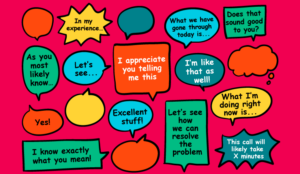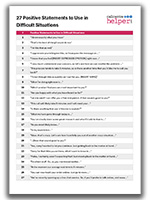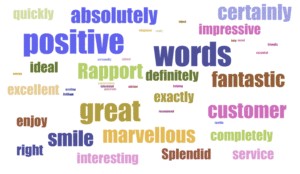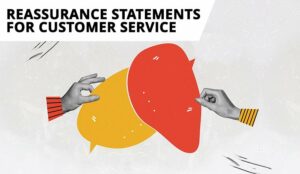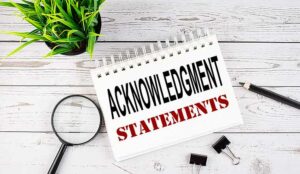In the contact centre, difficult conversations can quickly lead to awkward silences that damage rapport. Using positive statements can help advisors regain control of the conversation and steer it in the right direction.
To help start you out, we’ve compiled 27 positive statements that can be used to handle challenging situations with confidence and empathy.
Classic Examples of Difficult Situations
In the contact centre, advisors are often tasked with handling customer calls in difficult situations.
A classic example is handling contacts from angry customers, but there are many other situations that can be difficult, such as navigating customer indecision, dealing with nit-picking customers and those that tell never-ending stories.
Then there are those difficult scenarios that are caused by advisor stress, as the coronavirus outbreak underlined. When facing overwhelming contact volumes, which lead to high occupancy rates, advisors can understandably find things difficult.
Each of these difficult situations can lead us to those dreaded “tumbleweed moments”. These are moments of silence on the phone when the advisor just can’t quite work out what to say next, making a difficult situation much, much worse.
For these difficult scenarios, it can be invaluable to have a list of positive statements and stock phrases for things that we’re going to find challenging to deal with and workshop them through. This will help you to test them and see how comfortable advisors are with using them.
27 Statements to Use in Difficult Situations
In challenging conversations, using thoughtful and empathetic language can help build trust and ease tension. Here are some phrases you can use to navigate these situations successfully.
- “I know exactly what you mean”
- “That’s the kind of thing I would do too”
- “I’m like that as well”
- “I appreciate you telling me this, so I can pass the message on…”
- “I know that you feel [INSERT EXPRESSED EMOTION] right now…”
- “I very much understand your concern, so let’s see how we can resolve the problem …”
- “This process tends to take X minutes, so is there another time that you’d like me to call you back?”
- “I’ll run through this as quickly as I can for you, [INSERT NAME]”
- “What I’m doing right now is…”
- “Which product features are most important to you?”
- “Are you happy with what you have heard so far?”
- “Let me see if I can offer you a free trial period, if that sounds good to you?”
- “This call will likely take X minutes and I will need your…”
- “Is there anything that you’d like me to explain?”
- “What we have gone through today is…”
- “You’ve clearly done some great research and what I’d add to that is…”
- “As you most likely know…”
- “In my experience…”
- “Wow, that’s crazy. Let’s see how I can help you out of another crazy situation…”
- “…Does that sound good to you?”
- “Yes, sorry I wanted to let you continue. Just getting back to the matter at hand…”
- “Sorry for that little pause there, what I want to know is…”
- “Haha, I certainly wasn’t expecting that! Just moving back to the matter at hand…”
- “Excellent stuff. So, as you mentioned earlier…”
- “At the moment our average wait time is X minutes.”
- “You can now track your order online. Just go to www….”
- “We’ve recently opening up a live chat service. So, if you’d prefer to talk online, visit www…”
We will explore each of these statements below, explaining how they can be used in nine difficult situations:
- Positive Statements to Encourage Conversation
- Positive Statements to Take the Heat Out of a Situation
- Positive Statements to Use With the Impatient Customer
- Positive Statements to Prevent Customer Indecision
- Positive Statements to Support Vulnerable Customers
- Positive Statements for the Know-it-all Customers
- Positive Statements to Move the Conversation Forwards
- Positive Statements to Use in a Standoff
- Positive Statements to Use of Your IVR Messaging
Positive Statements to Encourage Conversation
Customers often don’t like to talk on the phone and can come across as nervous, shy or even angry. This makes problem-solving difficult, as the customer seems unwilling to engage.
So, we want to build rapport, which we can do by giving them quick verbal nods like: “yes”, “uh-hum” and “absolutely”. Yet creating rapport often comes back to one simple rule: people like people who are similar to them. If customers feel this similarity, then they are more likely to be open with you.
The three positive statements below will help you demonstrate commonality and help the customer open up.
1. “I Know Exactly What You Mean”
This statement helps to show the customer that they are being listened to and understood. “Exactly” is a good power word to help emphasize this point.
2. “That’s the Kind of Thing I Would Do Too”
To demonstrate commonality in this way helps to validate the customer’s decision-making. This validation will likely help to make the customer feel more comfortable in sharing more.
3. “I’m Like That As Well”
By using this positive statement we are creating an environment of “belonging” and “safety”. An experienced agent may even go one step further and mirror the customer’s tone.
Positive Statements to Take the Heat out of a Situation
Most customers don’t want to talk to you. It is seen as a nuisance for many in this digital age.
But let’s not look at this call in isolation. As Fran Fish of Mazaru adds: “Let’s say the customer has had a bad day, is tense and has had numerous bad bits of luck recently. All of a sudden the customer’s problem becomes much more stressful.”
It’s important to remember this context when dealing with angry customers. Their anger is not with you, as the advisor, so give them space to vent – as long as they are not overly abusive.
Once they have calmed down naturally (don’t ever say “calm down”), show empathy and move the conversation along. The positive statements below can help you do that.
4. “I Appreciate You Telling Me This, So I Can Pass the Message on…”
Letting the customer know that they were right to call you and that you are prepared to do something to confront their concern immediately shows them that you’re on the same side.
5. “I Know That You Feel [INSERT EXPRESSED EMOTION] Right Now…”
Acknowledging the emotion that the customer has expressed will show them that you are listening and understand how they feel. This is half the battle.
6. “I Very Much Understand Your Concern, So Let’s See How We Can Resolve the Problem …”
This statement helps the advisor show mutual understanding, a key ingredient of empathy. The use of the word “we” also signifies teamwork, as the advisor is taking responsibility for the matter.
For more positive statements to use with irate customers, read our article: The Right Words and Phrases to Say to an Angry Customer
Positive Statements to Use With Impatient Customers
These customers aren’t necessarily angry, but they will hint that they are in a rush to get off the phone and may grow frustrated when you cannot give them an immediate resolution.
Advisors often have to battle these difficult calls from impatient customers at certain times of the day: just before customers go to work, finish their lunch break or the contact centre closes. These are all common examples.
To best handle these situations, good advisors will be more direct with the customer, adjusting their tone and pacing to create a sense of immediacy.
Yet this is easier said than done in a difficult situation, so advisors may find it helpful to use the positive statements below to help navigate this scenario.
7. “This Process Tends to Take X Minutes, So is There Another Time That You’d Like Me to Call You Back?”
As an advisor, you should know how long each call type is likely to take to handle. This time will reassure the customer, so they feel comfortable to continue the call or rearrange it.
8. “I’ll Run Through This as Quickly as I Can For You, [INSERT NAME]”
Subtly signalling to the customer that the call is moving as quickly as possible helps the advisor to remove customer concerns about their performance.
9. “What I’m Doing Right Now is…”
An impatient caller needs to know why the call is taking so long, so we need to be signposting what we are doing. These updates will prevent impatience from turning into frustration or maybe even anger.
Positive Statements to Prevent Customer Indecision
Some customers just cannot make a decision and will either keep asking lots of questions or keep switching between different options. This is a frustrating situation for everyone involved.
To serve these customers well, we need to stay focused on the end goal. So our success here will depend on the advisor’s ability to reframe the conversation.
Can you, as the advisor, ask the right questions to match the customer’s needs and preferences to the right offering?
If so, you can promote one option over the other and help navigate the customer to the most appropriate offering.
So this all comes down to good questioning and building probing questions into our positive statements, just as we’ve done below.
10. “Which Product Features Are Most Important to You?”
This statement helps you to probe into what matters most to the customer and will therefore allow the advisor to narrow down the options for them.
11. “Are You Happy With What You Have Heard So Far?”
Taking control of the call and asking this question at certain points within the conversation may enable the advisor to spot the root of the customer’s uncertainty.
12. “Let Me See if I Can Offer You a Free Trial Period, If That Sounds Good to You?”
Indecision often come from their feeling that there is a lot riding on the call; they have this “fear factor”. Offering trial periods can help minimize the risk for the customer.
For more on perfecting your customer service questioning skills, read our article: Practical Tips for Effective Questioning and Probing Techniques
Positive Statements to Support Vulnerable Customers
Interacting with vulnerable customers can be challenging, especially when advisors haven’t had the necessary training to identify signs of vulnerability and handle the calls with care and respect.

“The frontline are often ill-equipped and lack confidence in dealing with vulnerable customers, feeling unsupported by management,” adds Jacqui Workman, Managing Director at KMB.
“Sometimes, there’s also no policy for addressing the problems, so advisors are unaware of what they should do. This can be particularly stressful for advisors who lack autonomy.”
So, while we would very much advocate creating a vulnerable customer policy and giving advisors specialist training, here are some positive statements that may help advisors in these difficult situations, in the meantime.
13. “This Call Will Likely Take X Minutes and I Will Need Your…”
Signposting everything that the customer will need to have before the call will enable to call to run smoothly. It also means that you can help them right away if they need anything and reassure them.
14. “Is There Anything That You’d Like Me to Explain?”
This will help you gauge whether the customer is keeping up with what you are saying. If their answer doesn’t convince you, be more obvious and remain patient.
15. “What We Have Gone Through Today is…”
Summarizing the call is especially important when you are working with vulnerable customers, so you can be sure that they have understood everything and they are aware of the next steps.
For a detailed guide on how to handle the difficult contacts, read our article: Dealing With Vulnerable Customers
Positive Statements for The Know-It-All Customers
Most of the time, it’s great when customers have done their research, as we don’t stop and explain everything. But it can sometimes be difficult when the customer implies that we are wrong.
However, you are the expert. You know for a fact that you are right – so it can be easy for a slight conflict to arise.
Of course you cannot be submissive just because they are the customer, but you don’t want to push away the customer by proving them wrong.
So you want to acknowledge their research and “add” to it instead of rebuking it. You can do this with the help of the positive statements below.
16. “You’ve Clearly Done Some Great Research and What I’d Add to That is…”
The first clause of this statement is a great example of acknowledging the customer. Then we use “and”, not “but”, so it doesn’t seem as though we are contradicting the customer.
17. “As You Most Likely Know…”
This statement helps play to the customer’s ego. Let them feel as though they were part of finding the solution. It may be difficult for the advisor, but they should remember that the customer cares about their opinion – otherwise they wouldn’t have called.
18. “In My Experience…”
Drawing on your experience, enables you as the advisor to present information as if it is inside knowledge. This makes it very difficult for the customer to undermine what you are saying.
Positive Statements to Move the Conversation Forwards
Not all difficult situations in the contact centre are unpleasant. You will often meet customers who are very friendly, but very talkative. In fact, they can keep you on the phone far longer than you want to be.
At the start we want to give them verbal nods and show acknowledgement of what they are saying – to show that we are listening to them.
However, when they just continue, give them their space and when it’s finally your turn to talk, use closed questions to minimize their responses and employ other call control techniques.
To take back control of the call and move the conversation forwards, acknowledge what the customer has said and then, quickly, add in one of the positive statements below.
19. “Wow, That’s Crazy. Let’s See How I Can Help You Out of Another Crazy Situation…”
By linking their situation to the matter at hand, through the double use of the word “crazy”, we can seamlessly move the conversation along. Just be careful the “wow” doesn’t come across as sarcastic.
20. “…Does That Sound Good to You?”
Once you have taken back control of the conversation, use closed questions when gathering information. These will help you stay on top of things.
21. “Yes, Sorry I Wanted to Let You Continue. Just Getting Back to the Matter at Hand…”
This should only be used in the most extreme of circumstances, when you stop giving the customer verbal nods and after an eternity they ask: “Are you’re still there?” Then this statement helps politely move the conversation along.
For guidance on how you can better acknowledge customers in the contact centre, read our article: The Top 12 Acknowledgement Statements for Customer Service
Positive Statements to Use in a Standoff
A standoff is a situation where there is a long pause. Either the customer says something truly bizarre which completely bamboozles the advisor, or the advisor says something which the customer simply doesn’t know the answer to.
Who will speak first?
These “tumbleweed moments” can be really awkward and have the potential to break any rapport that has previously been built up.
So here are some words and phrases to get you out of the standoff situation. The first is for when there is a long pause after the advisor has said something and the other two are for when the customer says something truly bizarre.
22. “Sorry For That Little Pause There, What I Want to Know is…”
Acknowledge the elephant in the room and take ownership of the pause when the customer doesn’t follow. Then, it’s take two and a chance to reframe the conversation.
23. “Haha, I Certainly Wasn’t Expecting That! Just Moving Back to the Matter at Hand…”
A little chuckle will help to take any awkwardness out of the conversation and make the customer feel comfortable in expressing themselves fully.
24. “Excellent Stuff. So, As You Mentioned Earlier…”
“Excellent stuff” is great to help validate what the customer has just said, while it allows us to quickly move back to the matter at hand, without refocusing on the customer’s comment.
Positive Statements to Use of Your IVR Messaging
Positive statements shouldn’t just relate to customer–advisor conversations, they can be applied elsewhere to minimize customer frustration and difficult situations for advisors down the line.
For starters, there is your website messaging and, of course, your IVR messages. Just look at how some organizations used these channels when dealing with the COVID-19 crisis.

“When contact volumes are overwhelming, we need to let customers know that we do want to talk to them, but we need to prioritize our most vulnerable customers,” says Fran Fish.
So make sure your IVR messaging reflects this to relieve pressure on your advisors while still sounding friendly and helpful. Here are some great positive statements to add to your system.
25. “At The Moment Our Average Wait Time is X Minutes.”
Sure, the customer may not be delighted to hear there is an hour’s wait until they get through to the contact centre, but it allows them to get on with other things in the meantime. It’s better than having to wait in anticipation for such a long time.
26. “You Can Now Track Your Order Online. Just Go to www….”
If you put this message up once for those who pressed the delivery option within the IVR, you could potentially save them a long wait and lower contact centre demand in the process.
27. “We’ve Recently Opened Up a Live Chat Service. So, if You’d Prefer to Talk Online, Visit www…”
Many customers don’t like to speak on the phone, so informing them of a new channel could be a nice surprise. Just don’t replay this message over and over again.
For more on the topic of IVR messaging, read our article: How to Write the Best IVR Messages – With Examples
Printable – 27 Positive Statements to Use in Difficult Situations
Do you want to download this to share with your team?
Get your free download of 27 Positive Statements to Use in Difficult Situations now:
Other Considerations for Difficult Situations
Using stock phrases as back-up positive statements should just be one of many tactics for overcoming each of the difficult situations highlighted above.
Many of these situations involve stress for both the advisor and the customer, which may be caused by high call volumes and long wait times, for example.
So with this situation in mind, Fran Fish introduces us to five other things that we can do to protect our contact centre advisors from being put into these awkward scenarios.
- Flagging a team leader – If the caller gets abusive or is particularly vulnerable, you should have a clear process for escalating the call – even if that just involves having an advisor raise their hand or send a desktop alert.
- Prioritizing customers – Which customers have been worst hit by the situation? Prioritizing these customers should be a key consideration, whether that’s by using website messaging to encourage other customers not to call or through more complex routing strategies.
- Avoiding micromanagement – Recognize that in certain difficult situations the normal rules do not apply. If an advisor feels constrained by the rules, they are not going to “go the extra mile” for a customer in need.
- Don’t use generalizations – In difficult situations, it’s important to be as clear as possible with customers. This includes avoiding generalizations. Get straight to the point, as stressed customers want you to be direct and to leave no room for confusion.
- Be proactive in your communications – A great proactive message is of high importance when it matters on an appropriate channel. If we can use messaging like this to inform the customer before they contact us, we can limit contact volumes.
For more on reaching out to customers proactively, read our article: What Is Proactive Customer Service? With a Definition, Examples and Key Challenges
For more on using positive language in your customer service conversations, read these articles next:
- Top 25 Positive Words, Phrases and Empathy Statements
- Positive Scripting for Customer Service
- Positive Language for Customer Service Conversations
Author: Charlie Mitchell
Reviewed by: Hannah Swankie
Published On: 27th May 2020 - Last modified: 10th Dec 2025
Read more about - Skills, Angry Customers, Editor's Picks, Fran Fish, Handling Customers, Jacqui Workman, Language, Positive Words, Rapport, Skill Development





